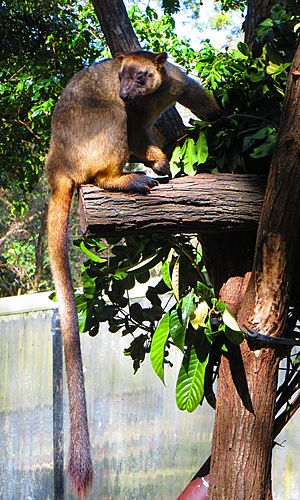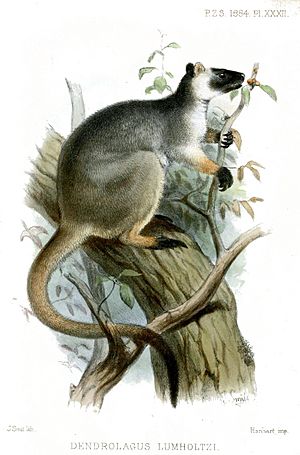Lumholtz's tree-kangaroo facts for kids
Quick facts for kids Lumholtz's tree-kangaroo |
|
|---|---|
 |
|
| Lumholtz's tree kangaroo (Dendrolagus lumholtzii) at David Fleay Wildlife Park, Burleigh Heads, Queensland | |
| Conservation status | |
| Scientific classification | |
| Genus: |
Dendrolagus
|
| Species: |
lumholtzi
|
 |
|
| Lumholtz's tree-kangaroo range | |

The Lumholtz's tree-kangaroo (Dendrolagus lumholtzi) is a special type of tree-kangaroo. It lives in the rainforests of the Atherton Tableland area in Queensland, Australia. This animal is named after Carl Sofus Lumholtz, a Norwegian explorer who first wrote about it in 1883. Local Indigenous Australians from the Dyirbal and Yidiny language groups might have called it Mabi or Mapi. The Lumholtz's tree-kangaroo is currently listed as "near threatened" by the IUCN. This means it could become endangered if we don't protect it.
Contents
What Does a Lumholtz's Tree-Kangaroo Look Like?
The Lumholtz's tree-kangaroo is the smallest of all tree-kangaroos. Males usually weigh about 7.2 kilograms (16 pounds). Females are a bit lighter, weighing around 5.9 kilograms (13 pounds).
Their body and head together measure between 480 and 650 millimeters. Their long tail adds another 600 to 740 millimeters to their length. These kangaroos have strong limbs, which help them climb trees. Their fur is short and a grizzled grey color. Their muzzle, toes, and the tip of their tail are black.
Where Do They Live?
Lumholtz's tree-kangaroos can live in many different places. They just need plenty of food. They also need places with stable tree structures where they can adapt and feel safe.
How Do Lumholtz's Tree-Kangaroos Behave?
Lumholtz's tree-kangaroos usually live alone. The only times they are not alone are when a male and female mate. They also spend a lot of time together when a mother is raising her joey (baby kangaroo).
Each kangaroo has its own "home range." This is an area where it lives and finds food. If another kangaroo of the same sex enters this area, the owner will usually act unfriendly. However, adult males might be okay with their male offspring visiting their range. A male kangaroo will protect his own area. He will also visit the home ranges of the females in his group. Mating can be quite rough and lasts about twenty minutes.
The Mystery of Blindness in Tree-Kangaroos
In June 2019, there were reports that some Lumholtz's tree-kangaroos were losing their eyesight. These animals are usually very good at hiding in the treetops. But blind kangaroos were found in unusual places, like schools, sheds, or even in the middle of roads. They seemed confused because they could not see.
A veterinarian named Dr. Andrew Peters studied some of these kangaroos. He found signs of damage to their optic nerves and brains. This made him think that a new virus might be causing the blindness.
Another person, Dr. Karen Coombes, has cared for injured tree-kangaroos for many years. She thought that dry weather might be a reason for the eye problems. Tree-kangaroos only eat leaves from rainforest trees. These leaves naturally have some toxins (poisons) in them. Dr. Coombes wondered if drier weather made these toxins stronger. However, no specific toxin has been found, and this idea is still being looked into.
Other scientists, like Dr. Amy Shima and Roger Martin, have also studied this issue. They have not found strong evidence of widespread blindness in Lumholtz's tree-kangaroos. Dr. Shima has examined nearly 100 eyes from kangaroos that had died. She found no proof of widespread eye problems. These findings were shared at a science conference. Scientists continue to study the health of these unique animals.
- Simon & Schuster's Guide to Mammals, entry 30
See also
 In Spanish: Dendrolagus lumholtzi para niños
In Spanish: Dendrolagus lumholtzi para niños


